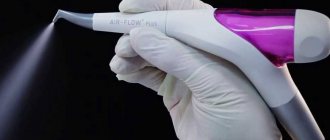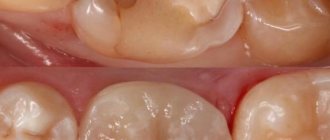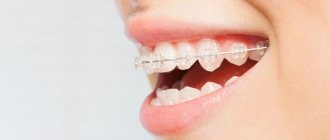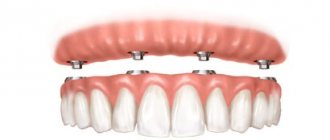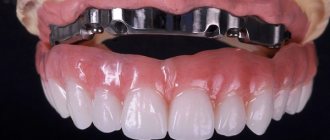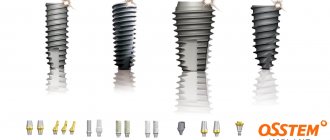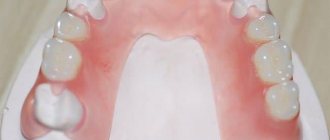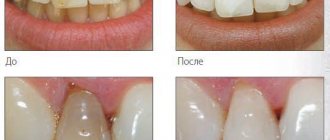Microdental dentures are a modern, effective method for eliminating tooth defects.
Modern dentistry offers several methods and systems of microprosthetics that allow you to restore the shape and function of a missing or damaged tooth. Microdental prosthetics - what is it? This method of orthopedic dentistry is prosthetics with minimal intervention in the tissues of healthy supporting teeth. Often this approach is the “golden mean” between conventional filling and direct dental prosthetics. It includes features of both methods and may well be an alternative to traditional filling.
Microprosthetics does not imply grinding existing healthy teeth, therefore it makes it possible to quickly and efficiently restore a tooth, returning its functions and aesthetics if the tooth defects are minor.
Advantages of microprosthetics
Onlays and inlays are similar in appearance to the fillings familiar to most patients. However, these microprostheses have comparative advantages - high accuracy of fit according to a previously taken dental impression, high aesthetic and functional characteristics. Thus, the ceramic material used allows you to effectively restore a tooth that will be indistinguishable in appearance from your own teeth - this applies to shape, shade, and the degree of transparency of the enamel.
Microprosthetics is a very effective method of restoring a damaged tooth; it has especially proven itself when it is necessary to restore the front teeth.
Materials for microprosthetics
- Inlays (special fillings, made in laboratories)
- Veneers or onlays (thin ceramic sheets)
- Pins (thin rods, used if the tooth is destroyed, but the roots are preserved)
- Fiberglass (allows you to restore 1-2 teeth in one visit to the dentist)
Like any dental service, microdental prosthetics has both pros and cons. Let's figure out why microprostheses are so good, and whether it is worth choosing this particular method of restoring damaged or lost teeth.
Indications for microprosthetics
There are several indications for microprosthetics:
- pathological abrasion of teeth;
- destruction of the crown - as a result of caries, trauma, which is especially in demand in cases where it is impossible to classically restore the crown with filling materials;
- complete destruction of the crown, saving only the tooth root - in this case, pins can be used to fix an artificial crown;
- missing tooth - the choice of prosthetic method in this case depends on the structure of the jaw, which tooth is missing and what caused its removal/loss;
- chips, cracks in enamel, darkening or inability to whiten yellow enamel - these indications apply to the installation of veneers.
Indications and contraindications
Indications for the installation of removable microprostheses are:
- loss of one or more teeth on the jaw arch,
- absence of chewing molars,
- consequences of the development of periodontitis and periodontal disease,
- the patient’s inability or unwillingness to install non-removable structures,
- the need for temporary replacement of defects during the production of permanent dentures.
Microprosthetics allows you to effectively replace dental defects. However, this method of restoring the aesthetics and functionality of teeth is not suitable for everyone. Contraindications to the use of the technique are:
- bruxism,
- malocclusion,
- serious periodontal pathologies,
- allergic reactions to prosthetic materials.
Relative contraindications are extensive dental caries, gingivitis, stomatitis and other oral diseases. The final decision on the possibility and advisability of installing a removable microprosthesis is made by the doctor based on the results of the patient’s examination.
Contraindications to microprosthetics
- poor oral hygiene;
- bruxism;
- multiple caries, damage to a large number of teeth;
- shallow cavity depth (for inlays);
- inability to provide conditions for prosthetics - absolute dryness of the tooth surface or cavity.
The need to use a particular method of microprosthetics is determined by the doctor individually, taking into account the characteristics of the dental system, the condition of the oral cavity, and the wishes of the patient.
Types of microprosthetics
This method of eliminating tooth or dentition defects consists of several types of prosthetics:
Adhesive
. Microprosthetics of a missing tooth are often performed using this method. In this case, the artificial tooth is fixed in place of the removed or fallen tooth with the help of supporting teeth - the use of inlays and onlays is assumed. Grinding of teeth is not implied here at all or is carried out in gentle ways. The advantage of this type in comparison with classical prosthetics is the preservation of most of the tissues of healthy teeth.
This method is indicated in cases where there is an allergic reaction to metal elements of dentures. It is worth noting that it can also be used as a temporary measure.
The artificial tooth can rest on inlays installed in adjacent teeth. If they have old fillings, the doctor simply replaces them with newly made inlays. If there are no old fillings in the teeth, the doctor creates a cavity in it, into which the inlay is installed. The artificial tooth subsequently rests on it. Creating a cavity does not imply removing the pulp - the tooth remains “alive”. The amount of tissue removed is insignificant, in contrast to classical turning. The procedure eliminates the loss of your own tissues completely if the tooth has already been filled in advance - only the material is replaced.
Inlays and overlays
. These microprostheses are manufactured in a dental laboratory using ceramic compounds. Tooth restoration is carried out in a similar way to a filling - pre-fabricated elements are installed in the tooth cavity using filling materials, as a rule, we are talking about liquid light-curing composites. The advantages of this type of microprosthetics are the precision of fitting the prosthesis to the individual parameters of the tooth cavity, the full correspondence of their properties (in terms of functionality and aesthetics) to the tooth’s own hard tissues. The inlay is a filling made in advance in the laboratory from durable and aesthetic material. The onlay is a relatively larger microprosthesis. The main indication for their use is the need to restore the shape and function of the chewing part of the teeth.
Veneers.
This type of microprosthetics is designed to hide tooth defects - chips, cracks, diastemas (gaps between teeth), slight curvature, scratches. Veneers can also be used if the shade of tooth enamel is unsatisfactory. Of course, they are more often used for the front teeth - noticeable when talking and smiling, their main function is to give aesthetics to the teeth.
Veneers are thin ceramic shells that are bonded to the outside of teeth. They are widely used in cases where other aesthetic dentistry procedures do not bring the desired result. Installation involves grinding off the top layer of enamel.
Lumineers
- a type of microprosthesis with an even smaller thickness (less than 0.3 mm). Their installation involves grinding down a smaller amount of tooth enamel, and in some cases this procedure can be avoided altogether.
Butterfly
. This design is installed mainly in adolescence, during the formation of permanent teeth. It is an element made of nylon; it serves as a microprosthesis for one or two teeth. Installation does not imply grinding of adjacent teeth.
Classification by installation method is not the only one. Microprostheses are also divided into types according to other characteristics: the method of transmitting the chewing load, the typography of the row defect, the material and manufacturing technology.
Microprosthetics in dentistry
This technological direction has a number of advantages over other methods. Teeth are restored in a gentle way, in most cases without damaging those nearby.
The structures that are used for such prosthetics, such as inlays and onlays, are made from casts. They are much stronger and also more durable than photo fillings or crowns.
In this way, you can achieve a flawless, “Hollywood” look to your teeth. This is proven by various photos of microdental prosthetics, which can be seen on the website of the Implantmaster clinic, as well as on other resources on the Internet.
Stages of microprosthetics
The microprosthetics procedure involves two main stages:
- The doctor treats the decaying tooth - removes tissue softened by caries, prepares the tooth for further prosthetics, and places a temporary filling in the tooth cavity. This stage also involves the creation of a tooth impression, from which a microprosthesis will subsequently be made in a dental laboratory. This allows you to take into account individual parameters and create a design that exactly fits the tooth cavity.
- The specialist installs the finished inlay/onlay into the tooth cavity or on its surface, ensuring reliable fixation using adhesive materials (composite cements). This allows the cavity to be filled hermetically and ensures reliable installation.
How microprostheses are installed
Many naively believe that microprosthetics are performed quickly, in 1-2 visits to the attending physician. In fact, this is completely wrong. This procedure is performed in several stages.
- An initial examination, the purpose of which is to determine the condition of the oral cavity, as well as to identify diseases that may interfere with this method of treatment. If any of the diseases is detected, it is necessary to treat it, which can take quite a long time.
- Preparing and taking an impression – after treatment, the tooth is processed. The top layer of enamel is ground down to install the lining, or the place where the chewing surface is destroyed is undermined. An impression is made using plaster, and a temporary veneer is installed for the patient.
- After a few days, the finished microprosthesis is checked and further processed if necessary.
- Finally, it is installed in place using cement.
Service life of microprostheses
The peculiarities of microprosthetics are that each element designed to replace a defect is manufactured in a dental laboratory - under special conditions that cannot be reproduced in the patient’s oral cavity. This makes it possible to achieve maximum polymerization, lightness, strength, and reduce the likelihood of tissue damage - this greatly affects the service life of microprostheses. Thus, the average service life of a microprosthesis on fiberglass is at least 5 years, inlays - 10-12, veneers - more than 20 years. These periods may vary depending on individual characteristics and compliance with the rules of care for microprosthetic teeth.
Care of microprostheses
It is necessary to brush teeth with inlays or veneers in the usual way, but it is better to avoid toothpastes with abrasives. After installing veneers, you will have to forget about teeth whitening procedures, but this is unlikely to be necessary - after all, these microprostheses are designed to improve the aesthetics of teeth.
It is very important to forget about a number of bad habits (such as biting your nails) - especially when it comes to installing veneers or lumineers. Otherwise, mechanical loads can lead to damage to microprostheses, and they will have to be replaced with new ones.
The use of dental floss and, if possible, an irrigator is advisable; the dentist will definitely explain the specifics of using these products to maintain hygiene.
Microdental prosthetics in Minsk
The specialists of the Medexpert Center for Family Dentistry will help you prepare your teeth for microprosthetics and install dentures The clinic specializes in dental treatment during sleep using drug sedation. This approach allows you not only to quickly and painlessly treat teeth, but also to combat stress and fear of dentists. Sedation is safe for the body of both adults and children, which allows its active use in any type of dental treatment.
